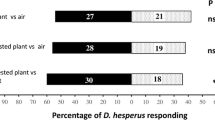Summary
Recruited workers of the leaf-cutting antAcromyrmex lundi learn the odour of the food fragment initially carried by a successful scout, and use this cue as a decision criterion during food collection. Citral, a natural deterrent odour, can also be associated as a food signal, showing how powerful olfactory learning is in this species. The role of both food-odour learning and a previously reported leaf-marking pheromone during diet selection by leaf-cutting ants is discussed.
Similar content being viewed by others
References
Blum, M. S., F. Padovani and E. Amante, 1968. Alkanones and terpenes in the mandibular glands ofAtta species.Comp. Biochem. Physiol. 26:291–299.
Bradshaw, J. W. S., P. E. Howse and R. Baker, 1986. A novel autostimulatory pheromone regulating transport of leaves inAtta cephalotes.Anim. Behav. 34:234–240.
Butenandt, A., B. Linzen and M. Lindauer, 1959. Über einen Duftstoff aus der Mandibeldrüse der BlattschneiderameiseAtta sexdens rubropilosa Forel.Arch. Anat. Microsc. Morph. Exp. 48:13–19.
Cherrett, J. M., 1968. The foraging behaviour ofAtta cephalotes L. (Hymenoptera: Formicidae). I. Foraging patterns and plant species attacked in tropical rain forest.J. Anim. Ecol. 37:387–403.
Daguerre, J. B., 1945. Hormigas del géneroAtta Fabricius de la Argentina (Hymenop. Formicidae).Rev. Soc. Entomol. Arg. 12:438–460.
Fowler, H. G., 1982. Habitat effect on fungal substrate selection by a leaf-cutting ant. J. N. Y.Entomol. Soc. 90:64–69.
Frisch, K. von, 1965.Tanzsprache und Orientierung der Bienen. Springer-Verlag, Berlin-Heidelberg-New York, 578 pp.
Hölldobler, B. and E. O. Wilson, 1986. Nest area exploration and recognition in leaf-cutter ants (Atta cephalotes).J. Insect Physiol. 32:143–150.
Howse, P. E., 1990. Pheromonal control of behavior in leaf-cutting ants. In:Applied Myrmecology— A World Perspective (R. K. Vander Meer, K. Jaffe and A. Cedeno, Eds.), Westview Press, Boulder, Colorado, pp. 427–437.
Hubbell, S. P., L. K. Johnson, E. Stanislav, B. Wilson and H. G. Fowler, 1980. Foraging by bucket-brigade in leaf-cutter ants.Biotropica 12:210–213.
Littledyke, M. and J. M. Cherrett, 1978. Olfactory responses of the leaf-cutting antAtta cephalotes (L.) andAcromyrmex octospinosus (Reich) (Hymenoptera: Formicidae) in the laboratory.Bull. Entomol Res. 68:273–282.
Menzel, R., 1968. Das Gedächtnis der Honigbiene für Spektralfarben. I. Kurzzeitiges and langzeitiges Behalten.Z. vergl. Physiol. 60:82–102.
Roces, F., 1990. Olfactory conditioning during the recruitment process in a leaf-cutting ant.Oecologia 83:261–262.
Salzemann, A., P. Nagnan, F. Tellier and K. Jaffé, 1992. Leaf-cutting antAtta laevigata (Formicidae: Attini) marks its territory with colony-specific Dufour gland secretion.J. Chem. Ecol. 18:183–196.
Vilela, E. F. and P. E. Howse, 1988. Pheromone performance as an attractive component in baits for the control of the leaf-cutting antAtta sexdens rubropilosa Forel, 1908 (Hymenoptera: Formicidae).An. Soc. Entomol. Brasil 17:107–124.
Author information
Authors and Affiliations
Rights and permissions
About this article
Cite this article
Roces, F. Odour learning and decision-making during food collection in the leaf-cutting antAcromyrmex lundi . Ins. Soc 41, 235–239 (1994). https://doi.org/10.1007/BF01242294
Received:
Revised:
Accepted:
Issue Date:
DOI: https://doi.org/10.1007/BF01242294




